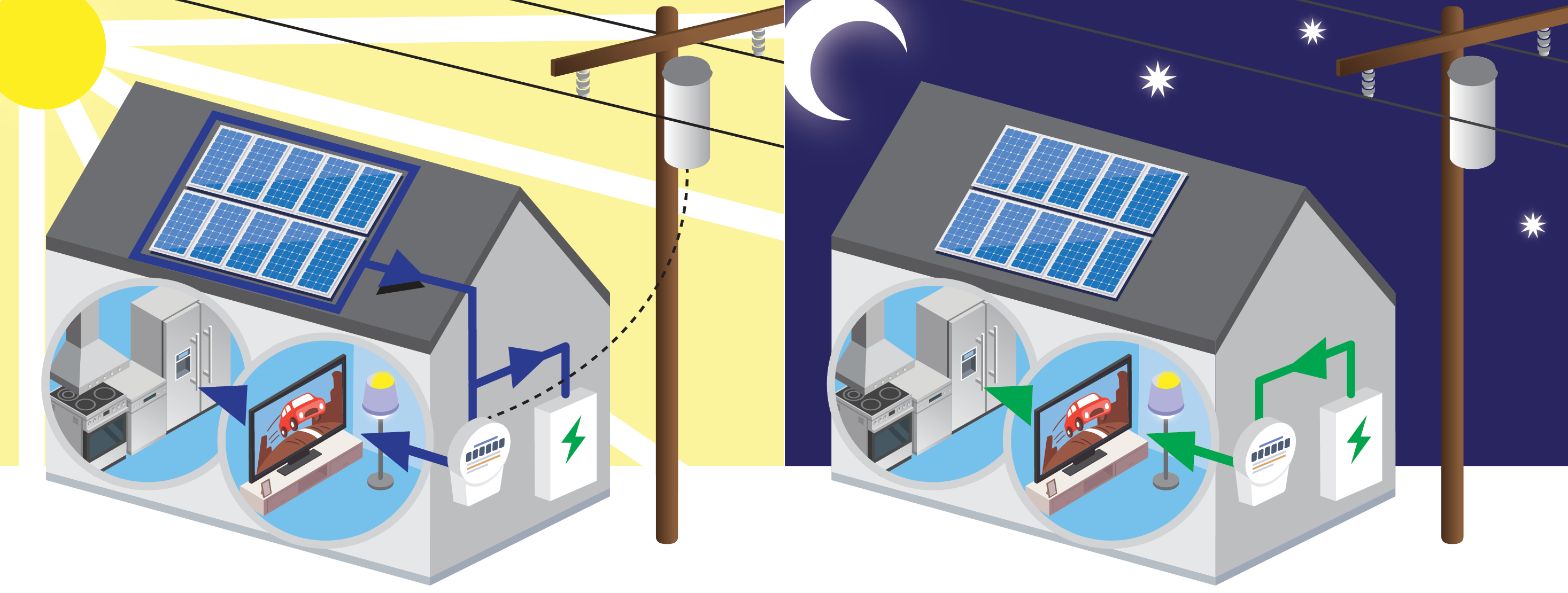Solar Billing Plan (SBP)
Supporting California's Clean Energy Goals
Harness the power of the sun, reduce your carbon footprint and save on your energy bill.

What is the Solar Billing Plan?
In December 2022, the California Public Utilities Commission (CPUC) voted to modernize the rooftop solar program to better balance the needs of the grid, the environment and customers.
The Solar Billing Plan helps promote grid reliability during the early evening, when the sun is down and energy use is high, in part by incentivizing solar paired with battery storage. Battery storage can extend the use of renewable energy to peak evening hours, helping to decrease the need to generate electricity from fossil fuels. This reduces overall grid costs, which improves energy affordability for all Californians.
Learn more about the CPUC decision.
Modernized Solar Pricing: Importing and Exporting Electricity
The Solar Billing Plan is based on the time-of-use (TOU) pricing structure, where the price of electricity used (imported) and sent back (exported) to the grid varies depending on the time of day. The TOU structure is intended to support California’s clean energy transition by sending price signals to customers when the demand on the grid is higher or lower.
You will receive bill credits for any surplus energy your solar system delivers back (exports) to the power grid. The energy export credit received is based on the value of kilowatt-hours sent to the electric grid at each hour of the day.
View Export Pricing.

Solar Pricing Plan for Residential Customers
Residential customers on the Solar Billing Plan have a Time-of-Use (EVTOU5) plan. Commercial customers will remain on their existing pricing plan.
The EVTOU5 plan has three time periods: on-peak, off-peak and super off peak. You can save on this plan if you use energy outside of the on-peak hours of 4 p.m. to 9 p.m. and by adding battery storage to your system to use stored energy during on-peak hours. All residential plans including those with solar are required to pay a Base Services Charge.
If your electricity is purchased by a Community Choice Aggregator (CCA), please contact your CCA for more information on import and export pricing.


Assistance Programs for Solar Customers
Your account is transitioning to the Solar Billing Plan because your solar system has reached the end of its 20-year NEM legacy period. Note: If you recently moved into a property that has solar, the NEM legacy period began when the solar panels were initially installed and interconnected.
Yes, you can still have Medical Baseline on the Solar Billing Plan. Solar Billing Plan customers are on the EVTOU5 pricing plan which includes a basic service fee and overall lower pricing per kWh. Your Medical Baseline discount may not be as significant because of this lower pricing.
As a Solar Billing Plan customer, you can oversize your system by no more than 50% with two requirements:
- The measurement of oversizing will be in comparison to the past 12 months of usage unless you do not yet have 12 months of usage or attest to having more recently increased usage.
- You must attest to an expected increase in usage corresponding with the system size within 12 months of interconnection.
Yes. The Solar Billing Plan monthly bill will reflect charges for electricity used (imported) and apply credits for electricity delivered back (exported) to the grid. The bill will also include a $16 basic monthly service fee as part of the TOU plan. All SDG&E customers, whether solar or non-solar, pay small charges for public purpose programs (non-bypassable charges). In months when there are excess export credits, the credits will roll over to following months until used or until a customer ends service. Export credits cannot be applied to non-bypassable charges.
As a Solar Billing Plan customer, solar paired with battery storage is a great way to save on your electricity bill. With battery storage, you can store excess energy generated during the day and use it during on-peak hours of 4 p.m. to 9 p.m. when electricity prices are highest. This can reduce the amount of electricity you use from the grid, which helps maximize your savings.
Community Choice Aggregators (CCAs) purchase or generate electricity on behalf of customers. If your electricity is purchased by San Diego Community Power (SDCP) or Clean Energy Alliance (CEA), your CCA sets the price for your Generation Import Charges and Generation Export Credits. Please refer to your CCA for more information about generation import and export pricing.
You will receive Generation Export Credits and Delivery Export Credits for the surplus energy your system sends to the grid. The price of the credits is determined by the California Public Utilities Commission (CPUC) and varies by time of day and season.
For more information about the CPUC’s Export Pricing, visit Solar Billing Plan Export Pricing.
If your electricity is purchased by San Diego Community Power (SDCP) or Clean Energy Alliance (CEA), please refer to your CCA for more information about Generation Import and Export pricing.
Visit My Energy Center to download your Export Data and Pricing spreadsheet each bill period.
Yes, all residential customers, including those with solar, are required to pay a Base Services Charge. This is a non-nettable charge that is not eligible to be offset by export credits. The Base Services Charge replaced the basic monthly service fee. For more information about the Base Services Charge, visit Base Services Charge | San Diego Gas & Electric.


